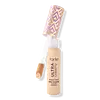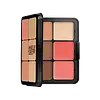What's inside
What's inside
 Key Ingredients
Key Ingredients

 Benefits
Benefits

 Concerns
Concerns

 Ingredients Side-by-side
Ingredients Side-by-side

Water
Skin ConditioningCyclopentasiloxane
EmollientGlycerin
HumectantPolymethylsilsesquioxane
PEG-9 Polydimethylsiloxyethyl Dimethicone
EmulsifyingCaprylic/Capric Triglyceride
MaskingCaprylyl Methicone
Skin ConditioningC13-15 Alkane
SolventSorbitan Isostearate
EmulsifyingDimethicone
EmollientPhenyl Trimethicone
Skin ConditioningAcrylates/Stearyl Acrylate/Dimethicone Methacrylate Copolymer
Hydroxyethyl Urea
HumectantMagnesium Sulfate
Aluminum Hydroxide
EmollientIsotridecyl Isononanoate
EmollientTriethyl Citrate
MaskingCetyl PEG/PPG-10/1 Dimethicone
EmulsifyingPolypropylsilsesquioxane
Dimethicone Crosspolymer
Emulsion StabilisingQuaternium-90 Bentonite
Triethoxycaprylylsilane
Sodium Benzoate
MaskingParfum
MaskingDisteardimonium Hectorite
StabilisingPotassium Sorbate
PreservativePolyhydroxystearic Acid
EmulsifyingPropylene Carbonate
SolventEthylhexyl Palmitate
EmollientIsopropyl Myristate
EmollientIsostearic Acid
CleansingLecithin
EmollientPropanediol
SolventDisodium EDTA
Polyglyceryl-3 Polyricinoleate
EmulsifyingBenzyl Salicylate
PerfumingHexyl Cinnamal
PerfumingLimonene
PerfumingOpuntia Ficus-Indica Stem Extract
Skin ConditioningHydroxycitronellal
PerfumingGeraniol
PerfumingMaltodextrin
AbsorbentAmyl Cinnamal
PerfumingLinalool
PerfumingButylene Glycol
HumectantSodium Hyaluronate Crosspolymer
HumectantCitric Acid
BufferingSpiraea Ulmaria Extract
Astringent1,2-Hexanediol
Skin ConditioningHydrolyzed Glycosaminoglycans
HumectantSodium Hyaluronate
HumectantAloe Barbadensis Leaf Extract
EmollientButyrospermum Parkii Butter
Skin ConditioningGlycyrrhiza Glabra Root Extract
BleachingOlea Europaea Fruit Oil
MaskingPersea Gratissima Oil
Skin ConditioningSqualane
EmollientUlmus Davidiana Root Extract
Skin ConditioningMangifera Indica Seed Butter
Skin ConditioningHelianthus Annuus Seed Oil
EmollientBenzyl Glycol
SolventPanax Ginseng Root Extract
EmollientHydrolyzed Hyaluronic Acid
HumectantPentaerythrityl Tetra-Di-T-Butyl Hydroxyhydrocinnamate
AntioxidantEthylhexylglycerin
Skin ConditioningPhenoxyethanol
PreservativeHyaluronic Acid
HumectantConvallaria Majalis Bulb/Root Extract
Skin ConditioningLeontopodium Alpinum Flower/Leaf Extract
Skin ConditioningLilium Candidum Flower Extract
Skin ConditioningMagnolia Liliflora Flower Extract
Skin ConditioningPaeonia Lactiflora Root Extract
Skin ConditioningRaspberry Ketone
MaskingTocopherol
AntioxidantTbhq
AntioxidantTitanium Dioxide
Cosmetic ColorantIron Oxides
Water, Cyclopentasiloxane, Glycerin, Polymethylsilsesquioxane, PEG-9 Polydimethylsiloxyethyl Dimethicone, Caprylic/Capric Triglyceride, Caprylyl Methicone, C13-15 Alkane, Sorbitan Isostearate, Dimethicone, Phenyl Trimethicone, Acrylates/Stearyl Acrylate/Dimethicone Methacrylate Copolymer, Hydroxyethyl Urea, Magnesium Sulfate, Aluminum Hydroxide, Isotridecyl Isononanoate, Triethyl Citrate, Cetyl PEG/PPG-10/1 Dimethicone, Polypropylsilsesquioxane, Dimethicone Crosspolymer, Quaternium-90 Bentonite, Triethoxycaprylylsilane, Sodium Benzoate, Parfum, Disteardimonium Hectorite, Potassium Sorbate, Polyhydroxystearic Acid, Propylene Carbonate, Ethylhexyl Palmitate, Isopropyl Myristate, Isostearic Acid, Lecithin, Propanediol, Disodium EDTA, Polyglyceryl-3 Polyricinoleate, Benzyl Salicylate, Hexyl Cinnamal, Limonene, Opuntia Ficus-Indica Stem Extract, Hydroxycitronellal, Geraniol, Maltodextrin, Amyl Cinnamal, Linalool, Butylene Glycol, Sodium Hyaluronate Crosspolymer, Citric Acid, Spiraea Ulmaria Extract, 1,2-Hexanediol, Hydrolyzed Glycosaminoglycans, Sodium Hyaluronate, Aloe Barbadensis Leaf Extract, Butyrospermum Parkii Butter, Glycyrrhiza Glabra Root Extract, Olea Europaea Fruit Oil, Persea Gratissima Oil, Squalane, Ulmus Davidiana Root Extract, Mangifera Indica Seed Butter, Helianthus Annuus Seed Oil, Benzyl Glycol, Panax Ginseng Root Extract, Hydrolyzed Hyaluronic Acid, Pentaerythrityl Tetra-Di-T-Butyl Hydroxyhydrocinnamate, Ethylhexylglycerin, Phenoxyethanol, Hyaluronic Acid, Convallaria Majalis Bulb/Root Extract, Leontopodium Alpinum Flower/Leaf Extract, Lilium Candidum Flower Extract, Magnolia Liliflora Flower Extract, Paeonia Lactiflora Root Extract, Raspberry Ketone, Tocopherol, Tbhq, Titanium Dioxide, Iron Oxides
Ethylhexyl Palmitate
EmollientSynthetic Fluorphlogopite
Dipentaerythrityl Hexahydroxystearate/Hexastearate/Hexarosinate
Skin ConditioningSynthetic Wax
AbrasivePolyglyceryl-2 Triisostearate
EmulsifyingHydrogenated Polyisobutene
EmollientSorbitan Sesquiisostearate
EmulsifyingMethicone
EmollientDimethicone
EmollientCopernicia Cerifera Wax
Vinyl Dimethicone/Methicone Silsesquioxane Crosspolymer
Alumina
AbrasiveTocopherol
AntioxidantParfum
MaskingPropanediol
SolventWater
Skin ConditioningSucrose Palmitate
EmollientEvodia Rutaecarpa Fruit Extract
Skin ConditioningTocopheryl Acetate
AntioxidantGlyceryl Linoleate
EmollientBenzyl Alcohol
PerfumingCitric Acid
BufferingPotassium Sorbate
PreservativeTin Oxide
AbrasivePentaerythrityl Tetra-Di-T-Butyl Hydroxyhydrocinnamate
AntioxidantSodium Hyaluronate
HumectantCI 77891
Cosmetic ColorantCI 77491
Cosmetic ColorantCI 77492
Cosmetic ColorantCI 77499
Cosmetic ColorantCaprylic/Capric Triglyceride
MaskingHelianthus Annuus Seed Wax
Skin ConditioningTriethoxycaprylylsilane
CI 19140
Cosmetic ColorantCI 15850
Cosmetic ColorantEthylhexyl Palmitate, Synthetic Fluorphlogopite, Dipentaerythrityl Hexahydroxystearate/Hexastearate/Hexarosinate, Synthetic Wax, Polyglyceryl-2 Triisostearate, Hydrogenated Polyisobutene, Sorbitan Sesquiisostearate, Methicone, Dimethicone, Copernicia Cerifera Wax, Vinyl Dimethicone/Methicone Silsesquioxane Crosspolymer, Alumina, Tocopherol, Parfum, Propanediol, Water, Sucrose Palmitate, Evodia Rutaecarpa Fruit Extract, Tocopheryl Acetate, Glyceryl Linoleate, Benzyl Alcohol, Citric Acid, Potassium Sorbate, Tin Oxide, Pentaerythrityl Tetra-Di-T-Butyl Hydroxyhydrocinnamate, Sodium Hyaluronate, CI 77891, CI 77491, CI 77492, CI 77499, Caprylic/Capric Triglyceride, Helianthus Annuus Seed Wax, Triethoxycaprylylsilane, CI 19140, CI 15850
 Reviews
Reviews

Ingredients Explained
These ingredients are found in both products.
Ingredients higher up in an ingredient list are typically present in a larger amount.
This ingredient is an emollient, solvent, and texture enhancer. It is considered a skin-softener by helping the skin prevent moisture loss.
It helps thicken a product's formula and makes it easier to spread by dissolving clumping compounds.
Caprylic Triglyceride is made by combining glycerin with coconut oil, forming a clear liquid.
While there is an assumption Caprylic Triglyceride can clog pores due to it being derived from coconut oil, there is no research supporting this.
Learn more about Caprylic/Capric TriglycerideCitric Acid is an alpha hydroxy acid (AHA) naturally found in citrus fruits like oranges, lemons, and limes.
Like other AHAs, citric acid can exfoliate skin by breaking down the bonds that hold dead skin cells together. This helps reveal smoother and brighter skin underneath.
However, this exfoliating effect only happens at high concentrations (20%) which can be hard to find in cosmetic products.
Due to this, citric acid is usually included in small amounts as a pH adjuster. This helps keep products slightly more acidic and compatible with skin's natural pH.
In skincare formulas, citric acid can:
While it can provide some skin benefits, research shows lactic acid and glycolic acid are generally more effective and less irritating exfoliants.
Most citric acid used in skincare today is made by fermenting sugars (usually from molasses). This synthetic version is identical to the natural citrus form but easier to stabilize and use in formulations.
Read more about some other popular AHA's here:
Learn more about Citric AcidDimethicone is a type of synthetic silicone created from natural materials such as quartz.
What it does:
Dimethicone comes in different viscosities:
Depending on the viscosity, dimethicone has different properties.
Ingredients lists don't always show which type is used, so we recommend reaching out to the brand if you have questions about the viscosity.
This ingredient is unlikely to cause irritation because it does not get absorbed into skin. However, people with silicone allergies should be careful about using this ingredient.
Note: Dimethicone may contribute to pilling. This is because it is not oil or water soluble, so pilling may occur when layered with products. When mixed with heavy oils in a formula, the outcome is also quite greasy.
Learn more about DimethiconeEthylhexyl Palmitate, also known as octyl palmitate, is created from 2-ethylhexyl alcohol and palmitic acid. It is a fatty acid ester.
The fatty acid content of Ethylhexyl Palmitate makes it an emollient. Emollients help soften and hydrate your skin by trapping moisture within.
Ethylhexyl Palmitate is also used to help improve the texture of cosmetics. It helps other ingredient dissolve in products and help disperse ingredients more evenly.
You'll likely find this ingredient in sunscreen, as it is often used to mix UV-blocking ingredients such as avobenzone and ethylhexyl triazone.
It can also help stabilize the fragrances in a product as a fragrance fixative.
Ethylhexyl Palmitate can be used to substitute mineral oil.
Due to its high fatty acid content, it may not be fungal-acne safe.
Learn more about Ethylhexyl PalmitateParfum is a catch-all term for an ingredient or more that is used to give a scent to products.
Also called "fragrance", this ingredient can be a blend of hundreds of chemicals or plant oils. This means every product with "fragrance" or "parfum" in the ingredients list is a different mixture.
For instance, Habanolide is a proprietary trade name for a specific aroma chemical. When used as a fragrance ingredient in cosmetics, most aroma chemicals fall under the broad labeling category of “FRAGRANCE” or “PARFUM” according to EU and US regulations.
The term 'parfum' or 'fragrance' is not regulated in many countries. In many cases, it is up to the brand to define this term.
For instance, many brands choose to label themselves as "fragrance-free" because they are not using synthetic fragrances. However, their products may still contain ingredients such as essential oils that are considered a fragrance by INCI standards.
One example is Calendula flower extract. Calendula is an essential oil that still imparts a scent or 'fragrance'.
Depending on the blend, the ingredients in the mixture can cause allergies and sensitivities on the skin. Some ingredients that are known EU allergens include linalool and citronellol.
Parfum can also be used to mask or cover an unpleasant scent.
The bottom line is: not all fragrances/parfum/ingredients are created equally. If you are worried about fragrances, we recommend taking a closer look at an ingredient. And of course, we always recommend speaking with a professional.
Learn more about ParfumPentaerythrityl Tetra-Di-T-Butyl Hydroxyhydrocinnamate (long name, huh?) is a synthetic antioxidant.
It is used to help stabilize other antioxidants or prevent the color from changing in a product.
As an antioxidant, it helps fight free-radical molecules. Free-radical molecules are capable of damaging our cells and other genetic material. Thus, antioxidants may reduce the signs of aging.
This ingredient is oil-soluble.
Learn more about Pentaerythrityl Tetra-Di-T-Butyl HydroxyhydrocinnamatePotassium Sorbate is a preservative used to prevent yeast and mold in products. It is commonly found in both cosmetic and food products.
This ingredient comes from potassium salt derived from sorbic acid. Sorbic acid is a natural antibiotic and effective against fungus.
Both potassium sorbate and sorbic acid can be found in baked goods, cheeses, dried meats, dried fruit, ice cream, pickles, wine, yogurt, and more.
You'll often find this ingredient used with other preservatives.
Learn more about Potassium SorbatePropanediol is an all-star ingredient. It softens, hydrates, and smooths the skin.
It’s often used to:
Propanediol is not likely to cause sensitivity and considered safe to use. It is derived from corn or petroleum with a clear color and no scent.
Learn more about PropanediolSodium Hyaluronate is hyaluronic acid's salt form. It is commonly derived from the sodium salt of hyaluronic acid.
Like hyaluronic acid, it is great at holding water and acts as a humectant. This makes it a great skin hydrating ingredient.
Sodium Hyaluronate is naturally occurring in our bodies and is mostly found in eye fluid and joints.
These are some other common types of Hyaluronic Acid:
Learn more about Sodium HyaluronateTocopherol (also known as Vitamin E) is a common antioxidant used to help protect the skin from free-radicals and strengthen the skin barrier. It's also fat soluble - this means our skin is great at absorbing it.
Vitamin E also helps keep your natural skin lipids healthy. Your lipid skin barrier naturally consists of lipids, ceramides, and fatty acids. Vitamin E offers extra protection for your skin’s lipid barrier, keeping your skin healthy and nourished.
Another benefit is a bit of UV protection. Vitamin E helps reduce the damage caused by UVB rays. (It should not replace your sunscreen). Combining it with Vitamin C can decrease sunburned cells and hyperpigmentation after UV exposure.
You might have noticed Vitamin E + C often paired together. This is because it is great at stabilizing Vitamin C. Using the two together helps increase the effectiveness of both ingredients.
There are often claims that Vitamin E can reduce/prevent scarring, but these claims haven't been confirmed by scientific research.
Learn more about TocopherolTriethoxycaprylylsilane is a silicone used to bind and stabilize ingredients.
As an emulsifier, it helps prevent ingredients from separating. This can help elongate the shelf life of products.
Triethoxycaprylylsilane is often used to coat mineral sunscreens ingredients to help give a better feel. It also helps reduce oxidative stress in sunscreens.
Learn more about TriethoxycaprylylsilaneWater. It's the most common cosmetic ingredient of all. You'll usually see it at the top of ingredient lists, meaning that it makes up the largest part of the product.
So why is it so popular? Water most often acts as a solvent - this means that it helps dissolve other ingredients into the formulation.
You'll also recognize water as that liquid we all need to stay alive. If you see this, drink a glass of water. Stay hydrated!
Learn more about Water